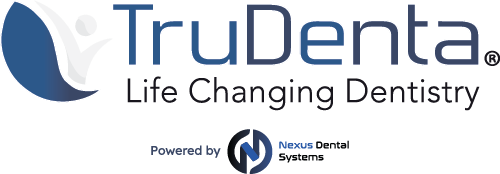20% of your existing patients suffer from DMSD, as do 20% of all Americans.
The National Institutes of Health estimates that over 80 million Americans suffer from one or more of the symptoms of DMSD.
- Chronic Headache
- Migraine
- Pains of the Head, Neck, Face and Jaw
- Tinnitus
- TMJ/D
- Vertigo
Team members quickly screen patients for force related dental conditions utilizing TruDenta technologies. The objective, digital examination and assessment results produce a consistent diagnosis which leads to predictable outcomes.
You see DMSD patients every day. Additional symptoms associated with DMSD include:
- Abfractions
- Broken and cracked teeth
- Failed restorations
- Clenching and grinding
These are all caused by improper or unbalanced dental forces. These same dental forces are often the cause of the patient’s pain.
The significant forces generated by improper force balance, clenching, grinding, and bruxing put the mouth and masticatory system under constant stress. Research has demonstrated that such stress and improper dental forces of the muscles, nerves, tendons, and ligaments within the dentomandibular region contribute to painful symptoms.
Patients have often seen multiple doctors seeking relief. They have typically found no answers except for over-the-counter and prescription pain killers, which only mask the symptoms, but do not resolve the underlying cause of pain.
Now dental professionals have a complete system to objectively diagnose these forces and systematically treat and monitor their patients who experience symptoms of force dysfunction.
Assessment technologies include:
- Digital bite force analysis
- Mandibular range of motion analysis
- Cervical range of motion analysis
- Health history forms
- Physical exam of the head, neck, face and jaw
Assessment & Treatment

Only Dental Professionals
In many cases, only dental professionals can help the estimated 80 million Americans suffering from the painful symptoms caused by improper dental forces, called dentomandibular sensorimotor dysfunction (DMSD). Read More
Assessing DMSD
20% of your existing patients suffer from DMSD, as do 20% of all Americans. Your team members quickly assess patients for "red flags" (which indicate DMSD), utilizing TruDenta's patented technologies. Read More
Bite Force Analysis
TruDenta uses digital force measurement technology, powered by Tekscan®, for evaluating the amount of bite force that is present during closure, at closure, and while chewing. The technology is so advanced that it actually calculates the bite force and motion on a tooth-by-tooth basis. This digital exam literally shows a movie of the bite force in action revealing abnormal forces in the nerves, muscles and ligaments that are often the cause of symptoms. Read More
Mandibular Range of Motion
A normal opening for an adult is 53 mm to 57 mm. Limited or restricted range of motion (less than 40 mm) is a reduction in an individual’s ability for normal range of movement. Along with opening movement, an individual should be able to slide their jaw to the left and to the right at least 25 percent of their total mouth opening in a symmetrical fashion. Read More
Cervical Range of Motion
The TruDentaROM is a system of hardware and software that digitally measures cervical range of motion (ROM) impairment based upon AMA guidelines. This directly affects the proprioceptive feedback system of the dental occlusion, TMJ, and the muscles of mastication. Read More
Doctor Chair Time
A typical case requires less than one hour of doctor time in the diagnosis and minor occlusal adjustments during the rehabilitation period.Treatments are performed by a trained team member once per week, in less than one hour. The most severe cases require 12 treatments. Therapies are spa-like, non-invasive and require no drugs or needles. Most patients report dramatic results after the very fist treatment. Note: The majority of patients utilize an orthotic only during the treatment period, up to a maximum of 12 weeks. Read More

Therapeutic Ultrasound
The goal of therapeutic ultrasound treatment is to return circulation to sore, strained muscles through increased blood flow and heat. Another goal is to break up scar tissue and deep adhesions through sound waves.Therapeutic exposure to ultrasound reduces trigger point sensitivity and has been indicated as a useful clinical tool for managing myofacial pain. Additionally, ultrasound also has been shown to evoke antinociceptive effects on trigger points. Read More

Microcurrent Stimulation
Sub-threshold microcurrent stimulation reduces muscle spasm and referral pain through low electrical signal. It also decreases lactic acid build-up and encourages healthy nerve stimulation. In particular, microcurrent electrotherapy has been shown to help increase mouth opening significantly. Read More
Low-Level Cold Laser
Low level laser/light therapy is one of the most widely used treatments in sports medicine to provide pain relief and rehabilitation of injuries. Over 200 randomized clinical trials have been published on low level laser therapy, half of which are on pain.Low level laser/light therapy decreases pain and inflammation, accelerates healing of muscle and joint tissue 25 to 35 percent faster than without treatment, and reconnects neurological pathways of nerves to the brain stem, thereby inhibiting pain. Read More



